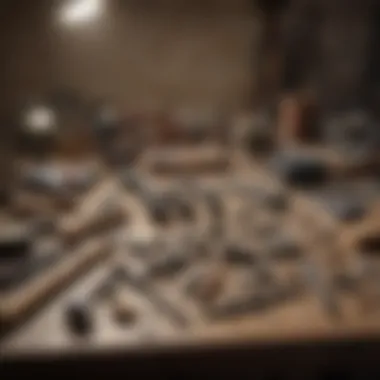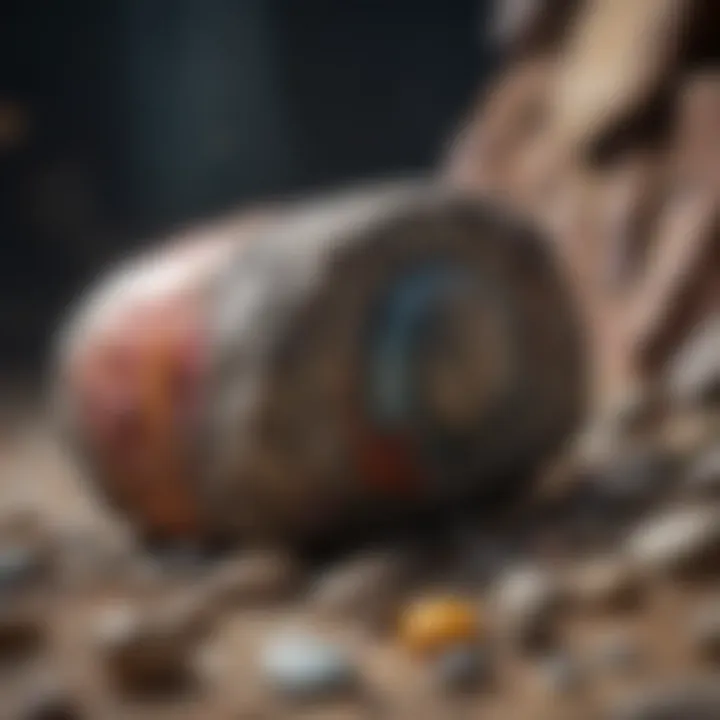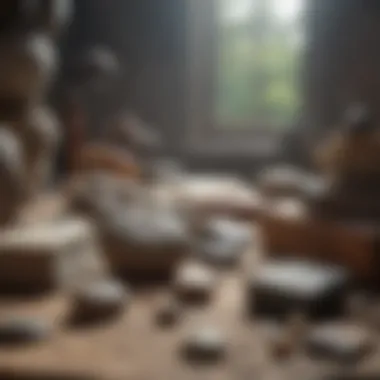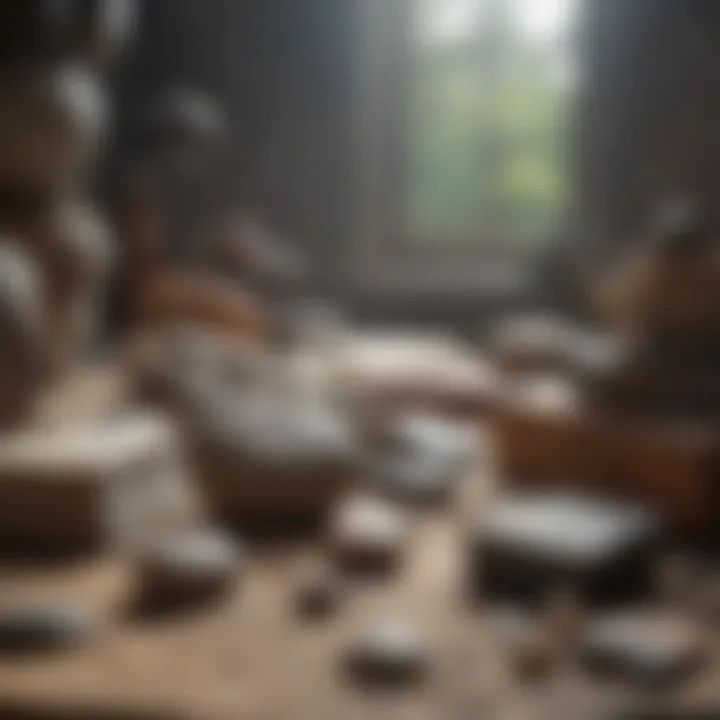Exploring Rock Polishing: A Comprehensive Guide


Intro
Rock polishing transcends mere aesthetics; it serves as a profound connection to nature and an educational endeavor. This hobby allows enthusiasts to explore the beauty not just of stones, but also of the earth’s history. As we delve into this guide, we will explore the intricacies of rock polishing—highlighting techniques, equipment, and materials essential for practitioners at any level. This comprehensive overview will not only nurture your skills but also enhance your appreciation for geology and craftsmanship.
Featured Collectible of the Month
Overview
Each month, hobbyists are presented with unique opportunities to explore a featured collectible. This month, we spotlight the stunning Amethyst Geode. Not only is this stone visually striking with its vibrant purple hue, but it also holds significance for both aesthetic and geological study.
Historical Significance
Amethyst has been valued for centuries across various cultures. In ancient times, Greeks and Romans believed it had protective qualities against intoxication. Historically, this gemstone was often used in royal regalia and religious artifacts, signifying power and purity. Understanding the history behind your collectible adds depth to your rock polishing experience.
Identification Techniques
Accurate identification of rocks and minerals is crucial for effective polishing. Here are some techniques to aid in this process.
Visual Characteristics
- Color: Observe the coloration. Varieties in hues can indicate different minerals.
- Luster: Determine the shine of the surface; whether it is metallic, glassy, or dull.
- Hardness: Perform a simple scratch test. The Mohs hardness scale is a good reference.
- Texture: The texture varies—some stones are smooth while others may be rough or have a crystalline structure.
Resources for Identification
For further assistance in identifying your rocks, consider the following resources:
- Wikipedia provides a wealth of information on mineral properties and classifications.
- Britannica offers detailed articles about geological features and rock types.
- Reddit has active communities discussing mineral identification.
- Facebook groups dedicated to rock collecting can also offer informal insight from fellow enthusiasts.
"The beauty of collecting rocks lies not just in their physical appearance, but in their journey from earth to your collection."
This guide aims to provide practical insights into the rock polishing process, transforming raw stones into polished beauties while also fostering a deeper connection with geology. Let this serve as a stepping stone on your journey into the captivating world of rock polishing.
Prologue to Rock Polishing
Rock polishing is an engaging pursuit that attracts a diverse community of hobbyists. Understanding this art goes beyond the mere act of smoothing stones; it encompasses a whole range of scientific inquiry, aesthetic appreciation, and tactile pleasure. This article outlines the importance of rock polishing as both a hobby and an educational tool, aimed at igniting curiosity and creativity in enthusiasts.
Understanding the Hobby
At its core, rock polishing satisfies the natural inclination to explore and refine materials. The process allows hobbyists to bring out the inherent beauty in rough stones. By learning to polish rocks, one not only develops technical skills but also gains insight into geology, mineralogy, and the various forces at play in nature. Enthusiasts often create stunning displays or collectible pieces that accentuate their artistic vision. Rock polishing can also serve as a meditative activity, providing a calming outlet for stress release.
Benefits of Rock Polishing
Engaging in rock polishing offers several key benefits. First, it promotes patience and attention to detail. Each stage of polishing—from initial grinding to final buffing—requires careful observation and the ability to identify when a rock has reached the desired finish. Furthermore, the hobby fosters a deeper appreciation for nature. As collectors research the origins and properties of different rocks, they develop a more profound connection to the earth.
Polishing rocks can also lead to potential social opportunities. Clubs and workshops around the theme of rock polishing are present in many regions, which allow enthusiasts to share experiences and exchange tips with one another. The sense of community adds value to the hobby, making it even more rewarding.
Overview of Rock Types
When it comes to rock polishing, understanding the types of rocks available is essential. Polished rocks not only showcase aesthetic qualities but also come with varying characteristics of hardness and durability, influencing the polishing process.
Common Polished Rocks
Some of the most common polished rocks include agate, jasper, and quartz. Each stone presents unique characteristics that contribute to its appeal. For instance, agate is known for its stunning banded patterns, making it a popular choice for jewelry and decorative items. Its versatility ensures that it can be shaped and polished into various forms.
Key Characteristics: Agate's natural complexity and color variations make it especially attractive for beginners. Moreover, it is relatively easy to polish. This accessibility makes it a common starting point for novice hobbyists.
Hardness and Durability
Understanding hardness and durability in rock polishing signifies a crucial part of the craft. The Mohs scale is often referenced, ranking minerals according to their hardness. Knowing how hard a rock is affects how one approaches the polishing process. For example, harder stones like sapphire require more intensive techniques and higher-quality abrasives.
Key Characteristics: A rock's hardness not only influences the time taken to polish but also the care needed when working with it. Softer stones can be more forgiving for beginners but may not hold the shine quite as well as harder varieties. Both factors are vital to achieving the desired polish and finish.
Essential Equipment for Rock Polishing
The practice of rock polishing demands a set of specific equipment that is crucial for achieving optimal results. This section details the essential tools and materials needed to embark on this hobby effectively. Each piece of equipment holds significance in the polishing process, influencing both the outcome and the experience itself.
Tumblers


Types of Tumblers
Tumblers are the heart of rock polishing. There are generally three types of rock tumblers: rotary, vibratory, and dual-drum tumblers. Each type offers unique benefits conducive to varying user needs and preferences. Rotary tumblers, for instance, are ideal for beginners. They spin rock and grit together smoothly for extended periods. This results in a high polish but requires a longer processing time. On the other hand, vibratory tumblers perform quicker polishing cycles. They utilize agitation rather than rotation, making them efficient for softer rocks, yet may struggle with harder materials. Lastly, dual-drum tumblers offer versatility; they allow users to work on different grades simultaneously without switching tumblers.
Choosing the Right Tumbler
Selecting an appropriate tumbler can significantly affect the polishing journey. Consider the size, speed, and noise level when making your choice. A large tumbler may accommodate more stones, making it ideal for enthusiasts who want to polish multiple pieces at once. However, the size often comes at the cost of increased noise, which could be problematic in smaller living spaces. A quieter model might suit hobbyists in residential areas better. Ultimately, it is essential to align the tumbler's capabilities with personal preferences and circumstances.
Polishing Grits and Compounds
Polishing grits and compounds serve as the means through which the rocks achieve their shine. They play a critical role in determining the final appearance of the polished stones.
Types of Grit
In rock polishing, different grits serve distinct purposes. The initial grinding typically uses coarse grits like 60 or 80 grit to shape the rocks. Progressing to finer grits, such as 220 or 600, refines the texture until achieving a smooth, polished finish. Ceramic media is also a popular choice among hobbyists. It helps in shaping softer stones quickly but can dull over time. The key is understanding each grit’s purpose to ensure a smooth transition through the polishing stages.
Application Techniques
Applying polishing grit involves a careful approach. Begin with the coarsest grit first, gradually working to finer grits. This sequential method prevents scratching and ensures an even polishing layer. Many hobbyists recommend adhering to the recommended timeline for each stage, monitoring the stones closely. While it is easy to become eager, patience is crucial to achieve the best results. Over-application or insufficient time with each grit can lead to lackluster finishes.
Safety Equipment
Handling rocks and polishing compounds necessitates proper safety equipment to protect enthusiasts during the polishing process. Safety should never be overlooked in any hobby.
Protective Gear
Utilizing protective gear is fundamental in rock polishing. Essential items include gloves, safety goggles, and dust masks. Gloves protect hands from sharp edges and gritty substances, while goggles provide protection against debris. Masks guard against inhaling dust, particularly from fine grit. Each component plays its part in ensuring a safe and enjoyable hobby experience.
Proper Ventilation
Ensuring proper ventilation cannot be understated. Many tumblers generate dust when operational, leading to an unhealthy environment if left unchecked. Keeping workspace well-ventilated helps avoid respiratory problems related to fine particles. Simple measures like opening windows or using exhaust fans can significantly enhance air quality.
Proper equipment care and safety gears are foundational for a safe and effective polishing journey.
In summary, the right equipment sets the stage for a successful rock polishing experience. Understanding the unique characteristics and advantages of tumblers, polishing grits, and safety equipment allows hobbyists to tailor their choices to their needs. Thus, novices and experienced collectors alike can truly appreciate the beauty of polished rocks.
Techniques for Effective Polishing
Techniques for effective polishing are central to achieving high-quality results in rock polishing. These methods not only enhance the aesthetic appeal of the stones but also play a critical role in ensuring their longevity. Mastering these techniques can significantly impact the overall success of the polishing process and the satisfaction of the hobbyist. Key elements of the polishing process range from initial cleaning to the final stages of polishing, each contributing uniquely to the final outcome.
Basic Polishing Steps
Initial Cleaning
Initial cleaning is crucial in the rock polishing process. This step ensures that all foreign materials, such as dirt and grime, are removed before polishing begins. Effective cleaning prevents contamination during subsequent stages, which can adversely affect the final appearance and quality of the polished rock.
A key characteristic of initial cleaning is its simplicity and efficiency. Many hobbyists appreciate this step as it requires minimal tools and can be done quickly. A unique feature of this process is the use of water and mild cleaning agents. This can advantageously eliminate debris without damaging the rock.
However, hobbyists need to be cautious. Improper cleaning methods or overly abrasive materials can scratch or dull the surface of the stone. Therefore, using soft brushes and gentle cleaning agents is vital to preserve the rock's natural beauty. The importance of careful handling during initial cleaning cannot be overstated, as it lays the foundation for successful polishing.
Stages of Polishing
The stages of polishing involve a systematic approach to achieving a glossy finish. This multi-step process usually consists of coarse grinding, medium grinding, fine grinding, and buffing. Each phase serves to progressively refine the stone's surface, removing scratches and imperfections.
A significant benefit of breaking the stages down is the effectiveness in ensuring each rock receives the attention it requires. Many hobbyists find this methodical approach beneficial because it allows for continual assessment of the stone's progress. A unique feature of these stages is the progression through different grits of polishing compounds, which facilitates the gradual improvement of the stone’s finish.
However, there are some drawbacks to consider. Moving too rapidly through the stages may result in a subpar finish. Patience is essential in this process. Furthermore, the variety of stones may require different polishing techniques, thus increasing complexity. Hence, understanding the specific characteristics and needs of each stone is crucial for effective polishing.
Advanced Techniques
Use of Vibratory Tumblers
The use of vibratory tumblers represents an advanced technique in rock polishing. Unlike traditional rotary tumblers, vibratory tumblers utilize vibrations to create a uniform polishing action. They can expedite the polishing process and enhance efficiency by allowing for a more consistent contact with the rocks and grits.
One of the key characteristics of vibratory tumblers is their ability to save time. Hobbyists often find them beneficial, especially when polishing multiple stones at once. The unique feature of this technique is its ability to polish rocks without as much wear and tear on the stones, making it suitable for fragile materials.
However, it's important to be aware of potential disadvantages. Vibratory tumblers can be more expensive than traditional tumblers, and they require careful monitoring. Improper settings may lead to undesired results, such as uneven polishing. Therefore, understanding how to adjust the vibratory action is necessary for optimal outcomes.
Methods for Specialty Stones


Methods for polishing specialty stones encompass techniques aimed at unique or rare varieties of rocks, such as opals or softer stones like calcite. These stones often need specialized materials and careful application of techniques to prevent damage during polishing.
A hallmark of these methods is the tailored approach to dealing with the specific needs of different stones. Many hobbyists view this as a valuable aspect of learning, as it allows for an understanding of the unique nature of each specimen. A unique feature of these methods is the reliance on gentler polishing compounds and slower techniques to reduce the risk of breakage.
However, some challenges may arise when polishing specialty stones. The need for specialized knowledge and tools can be a barrier for hobbyists. Additionally, the results may not always be as predictable compared to more common stones. Enthusiasts should be mindful of these aspects and do their research thoroughly before embarking on polishing specialty stones.
"Understanding both the basic and advanced techniques is crucial for successful and enjoyable rock polishing, paving the way for mastery in this rewarding hobby."
In the realm of rock polishing, effective techniques serve as the building blocks for a rewarding hobby and a pathway to artistic expression.
Sourcing Materials at Hobby Lobby
Sourcing the right materials is fundamental for any rock polishing hobbyist. Hobby Lobby stands out as a preferred retail outlet due to its wide range of supplies that cater to both beginners and experienced collectors. The store provides a convenient location to find essential tools and materials necessary for the rock polishing process.
When selecting materials, it’s important to consider several specific elements. First, the quality of tumblers and grits available can impact the final result of your polished rocks. Hobby Lobby often has access to various brands, allowing you to choose equipment that suits your specific needs.
Furthermore, browsing in-store allows for physical inspections, ensuring that you acquire tumblers that are robust and designed for durability. Factors to evaluate include the size capacity of tumblers, noise levels, and motor strength.
Additionally, Hobby Lobby frequently offers seasonal discounts on relevant items. This is beneficial for enthusiasts looking to maximize their budget. Many hobbyists find that being aware of the sales can lead to significant savings. Moreover, the store tends to stock a variety of polishing grits, from coarse to fine, which allows you to select the right one for your project easily.
Another aspect worth noting is the store’s commitment to customer service. Knowledgeable staff can assist in answering specific questions about products, which might aid you in making informed decisions about your purchases.
"Purchasing materials locally allows for a more tactile experience, fostering a deeper connection with the hobby."
Overall, sourcing your materials at Hobby Lobby provides both practicality and support for developing your rock polishing skills. It encourages a more engaged experience, making the entire process far more enjoyable and efficient.
Shopping for Equipment
When shopping for equipment at Hobby Lobby, it is essential to focus on finding quality tumblers. Look for tumblers with good reviews for consistent performance. Many hobbyists recommend the Lortone line for its reliability. Also, consider the capacity you need based on how many rocks you want to polish at once.
Key considerations while shopping include:
- Motor strength: Ensure the tumbler has enough power for your rock types.
- Noise level: Some tumblers are quieter than others, which can be a factor if you live in a shared space.
- Durability: Particularly if you plan on working with more abrasive materials.
Finding Polishing Grits
Finding the right polishing grits at Hobby Lobby can be straightforward if you know what to look for. The store typically offers a variety of grit sizes, allowing for proper progression through the polishing stages. It is beneficial to buy a set that includes coarse, medium, and fine grits to cover all necessary stages of polishing.
Consider checking for specialized grits that might cater to specific stone types. Some stones may require unique grits for optimal results. It can also be helpful to consult product labels to ensure they are suitable for your needs.
User Experience and Recommendations
User experience at Hobby Lobby generally receives positive feedback. Many hobbyists appreciate the combination of a broad selection and accessible pricing. It’s not uncommon to find favorable reviews highlighting the practical layout of the store, which aids in quickly locating materials.
Recommendations often include utilizing the store’s website for preliminary research before visiting. This saves time and gives you a better idea of what items are in stock. Don’t hesitate to ask staff for their recommendations or advice based on your specific polishing projects. Doing so can lead to new insights that enhance the polishing experience.
Caring for Your Polished Rocks
Caring for your polished rocks is crucial for maintaining their beauty and longevity. After spending considerable effort on polishing, it is essential to ensure that these rocks remain in great condition. Proper care not only enhances their appearance but also protects the investment of time and resources you have made in this hobby. Understanding maintenance and display options can significantly impact your overall rock polishing journey.
Cleaning and Maintenance
Maintaining the cleanliness of polished rocks helps in preserving their shine and color. The first step is to handle them with care to avoid scratches or other forms of damage. When cleaning, use soft microfiber cloths that won't scratch the surface. Avoid harsh chemicals that could dull the finish.
Here are a few effective methods for cleaning:
- Soaking: Immerse the rocks in a solution of warm water and a gentle dish soap for about 15 to 20 minutes. This helps loosen any dirt or grime.
- Rinsing: After soaking, rinse them thoroughly under running water. It is vital to ensure that no soap residue remains.
- Drying: Pat the rocks dry with a clean cloth. Avoid air drying, as this can lead to water spots.
Maintaining your rocks is not just about cleanliness. Periodically check for any signs of wear. If you notice diminished shine, consider re-polishing them using appropriate grits and polishing compounds.
Display Considerations
Display plays a critical role in showcasing your polished rocks. The way they are displayed can enhance their natural beauty while offering protection. Here are some key considerations:
- Light Conditions: Keep your rocks out of direct sunlight to prevent fading or discoloration over time. Indirect sunlight allows for an appealing glow without harming the surface.
- Display Cases: A glass or acrylic display case can protect your rocks from dust and accidental damage while allowing a full view of their beauty.
- Placement: Arrange rocks by size, color, or type for an organized presentation. Consider using felt pads or cushioning materials in display containers to minimize movement or scratches.
- Regular Checkups: Rotate the display or change the arrangement periodically. This helps to prevent any long-term wear from a fixed position and keeps the display vibrant.
"Caring for polished rocks goes beyond aesthetics; it also reflects the commitment of the hobbyist to preserve their craft."
Taking the time to care for your polished rocks will profoundly enhance your enjoyment of the hobby. Simple cleaning and thoughtful display can make a significant difference. By doing so, you ensure the rocks continue to bring you joy and connection to the fascinating world of geology.


Community and Resources for Rock Polishing
Building a community around rock polishing is vital for enthusiasts. Engaging with others who share the same passion fosters a sense of belonging. This community provides support and guidance. It can also lead to the sharing of tips, techniques, and resources. Networking with fellow hobbyists can enhance your skills and make the hobby more enjoyable.
Resources are equally important. They can range from online forums to local workshops. These venues help hobbyists learn and grow. Moreover, they provide a platform for sharing experiences and accessing valuable information.
Online Forums and Groups
Online forums and groups act as virtual meeting places. They are a hub of knowledge for hobbyists of all skill levels. Members share their experiences, knowledge, and even resources.
Connecting with Experts
Connecting with experts can greatly benefit rock polishing enthusiasts. Experts offer guidance that can help amateurs avoid common pitfalls. They can share their know-how on equipment, techniques, and materials. Being able to ask questions and receive feedback is a key characteristic of these forums. This interaction can enhance a hobbyist's experience.
A great advantage of this connection is the ability to learn directly from seasoned veterans. However, it can sometimes be overwhelming. There may be too much information to absorb at once. Yet, the benefits often outweigh the challenges.
Sharing Your Work
Sharing your work in online forums can build confidence and inspire others. Displaying polished stones allows for appreciation and constructive criticism.
The key feature of sharing work is the sense of achievement it brings. It is not just about showing finished pieces; it is about partaking in a communal journey of improvement. Each shared image can spark discussions that lead to learning.
Benefits include gaining new perspectives on your work. However, some might feel discouraged by comparisons. Nonetheless, this sharing can be a motivating force in the rock polishing community.
Workshops and Local Meetups
Workshops and local meetups open doors to hands-on experiences. They provide direct interaction with tools and experts. This practical exposure can significantly enhance learning.
Finding Local Resources
Finding local resources is crucial for any rock polishing enthusiast. Local shops, clubs, and events often host materials and tools necessary for the craft. This easy access makes it user-friendly, especially for beginners.
The primary advantage of local resources is the ability to physically inspect tools and materials. This firsthand experience can enhance purchasing decisions. However, some locations may lack diversity in equipment. This could limit choices for certain specialized needs.
Benefits of Hands-On Learning
Hands-on learning in workshops allows for immediate feedback. This experience is extremely beneficial. It provides a platform to practice techniques under expert supervision.
The primary characteristic of hands-on learning is its interactive nature. It encourages learners to ask questions and receive real-time advice. This can lead to a deeper understanding of the craft.
While workshops can be costly, the insights gained often justify the expense. They create a memorable learning experience that can ignite a lifelong passion for rock polishing.
The Educational Value of Rock Polishing
Rock polishing goes beyond mere aesthetics. This hobby holds significant educational value that enriches both the mind and the senses. It fosters a unique intersection of science and art. Engaging in this craft encourages a deeper understanding of geology, material properties, and the creative process.
Developing Scientific Knowledge
When hobbyists embark on the journey of rock polishing, they inadvertently delve into the realm of earth sciences. This activity promotes the study of mineralogy and geology. Through the process, individuals learn about the formation of different rock types and their unique characteristics. Knowledge about the Mohs hardness scale becomes essential. Understanding hardness helps hobbyists determine the appropriate polishing grit to use on various stones.
Additionally, the chemical reactions involved in polishing provide hands-on learning opportunities. For example, knowing how silica compounds interact with stones can enrich one's comprehension of material science. Such insights illuminate the fundamental structures that compose our planet.
Enhancing Artistic Appreciation
Polishing rocks also nurtures a keen sense of artistry. It encourages participants to appreciate the beauty found in natural materials. The process allows for creative expression. Selecting stones based on color, texture, and patterns can spark imaginative thinking. This choice impacts not only the final outcome but also enhances the visual experience as hobbyists observe the transformation of rough stones into polished gems.
Furthermore, crafting displays for polished rocks requires design skills. The thoughtful arrangement of colors and shapes into a cohesive presentation reflects an aesthetic understanding. Hobbyists often find joy in visiting art galleries, examining how artists portray natural materials. This exploration can strengthen the connection between nature and artistic creation.
Integrating both scientific and artistic elements, rock polishing serves as more than a mere pastime. It cultivates an environment of learning and creativity. Consequently, it nurtures a well-rounded appreciation for the intricacies of the natural world.
"Rock polishing is not just about beauty; it encompasses art, science, and history, blending them into a rewarding experience."
Through this multifaceted engagement, individuals not only improve their rock collection but also enhance their broader educational journey.
Closure
The conclusion of this article serves as a crucial segment that encapsulates the essence of rock polishing as more than just a hobby. It showcases the intricate interplay between art and science, shedding light on how enthusiasts can derive joy and knowledge from this craft. Rock polishing engages both the mind and the hands, catering to individuals who seek to deepen their understanding of geology while indulging in creativity.
The Future of Rock Polishing as a Hobby
The future of rock polishing appears bright. As technology advances, the accessibility of high-quality tumblers and polishing materials increases. New enthusiasts can benefit from improved user-friendliness found in modern machines. Additionally, interest in sustainable practices encourages hobbyists to explore local sources for materials. The community surrounding this hobby is expanding, with online forums and local workshops gaining traction. These environments foster sharing of knowledge and techniques, making it easier for newcomers to connect with seasoned hobbyists. Further, as the importance of STEM education grows, rock polishing could serve as an engaging tool for teaching geology to younger generations.
Final Thoughts
In closing, rock polishing invites individuals to explore a rich blend of scientific inquiry and artistic expression. It opens doors to a deeper appreciation of nature’s beauty and the geological processes that shape our world. Those who embark on this journey will discover not only polished stones but also an enduring sense of accomplishment and connection to the earth. Whether you are just starting out or are a seasoned expert, the potential for growth and understanding in this hobby is limitless, making it a truly rewarding pursuit.



